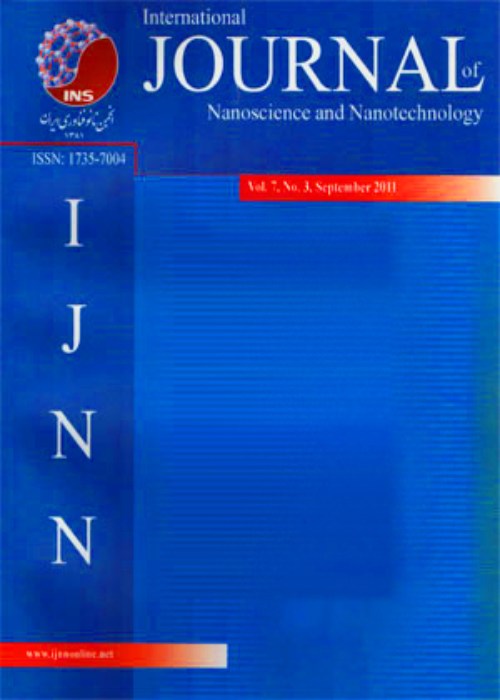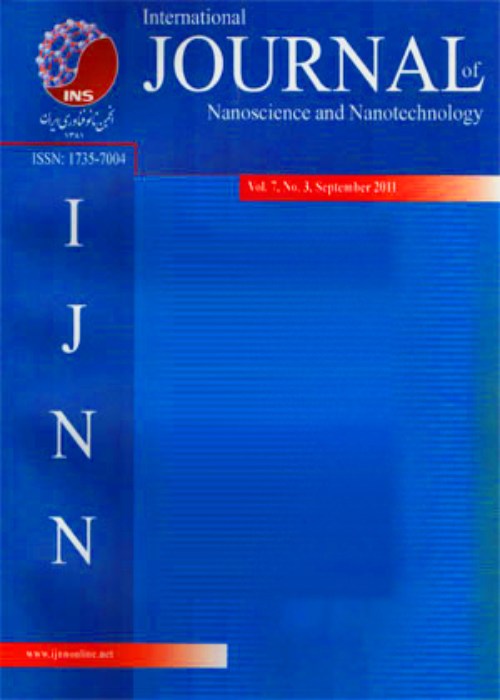فهرست مطالب

International Journal Of Nanoscience and Nanotechnology
Volume:19 Issue: 2, Spring 2023
- تاریخ انتشار: 1402/02/11
- تعداد عناوین: 6
-
-
Pages 65-76
A novel route for the synthesis of pure and nickel (Ni) doped copper oxide (CuO) nanoparticles via a simple co-precipitation process has been presented. The effect of the concentration of the dopant Ni (0, 2, and 4 mol %) on its properties has been carefully investigated. It has been reported that Ni doping is successfully achieved through the synthesis route. The structure and morphology were analyzed by using X-ray diffraction, Fourier transform infrared spectroscopy, and field emission scanning electron microscopy. X-ray diffraction analysis proved that prepared nanoparticles are highly pure and crystalline having a monoclinic structure and the crystallite size increases (13 nm to 17 nm) with Ni doping. Fourier transform infrared spectrum show successful Ni doping in the CuO system. Optical properties were investigated using UV-vis spectroscopy and the calculated band gap energies are 4.64 and 4.71 eV for pure and doped CuO, respectively. Electrical properties (dielectric constant (</em> ), dielectric loss (tan δ), and AC conductivity (</em> ) were studied using room temperature impedance spectroscopy. Energy dispersive X-ray spectrum of undoped and Ni-doped CuO to confirm the prepared sample composition has also been presented and discussed.</em>
Keywords: Co-precipitation, Copper oxide, Electrical property, Nanoparticles, Nickel doping, Optical property -
Pages 77-84
This paper studied a potential hazard of titanium dioxide nanomaterials in the primary sreening methods on the sample of bull sperm. A method for stabilizing metal nanopowders and their derivatives for biomedical studies is proposed. It was found that the complex of titanium dioxide doped with silver (Ag-TiO2) and nanopowder of titanium dioxide (TiO2) at concentrations of 3 mg/ml initiate pathological changes in the bull sperm: the release of phospholipids as a result of the destruction of membranes and morphological abnormalities (abnormalities of the head, middle part, and tail, as well as the absence of acrosome, etc). The pathological effect of Ag-TiO2 nanocomposite was more pronounced. Doping with silver can increase the toxicity of nanotitanium dioxide, which requires further in-depth experimental studies using different concentrations by in vivo and in vitro methods.
Keywords: Bull Sperm, Nanomaterials, Screening, Titanium dioxide -
Pages 85-95
Numerous metal oxide nanomaterials, such as titanium dioxide (TiO2</sub>), tin oxide (SnO2</sub>), and zinc oxide (ZnO), are highly suitable for the fabrication of effective humidity sensors. Comparatively, ZnO is considered as metal oxide with the highest potential due to its unique properties, such as the enormous excitation binding energy of 60 meV, a direct wide bandgap (3.37eV), and the ability to be synthesized and grown at low temperatures. To further enhance the sensing performance of ZnO structure for humidity sensing, parameters such as the morphology and crystallinity of the ZnO structure can be optimized through control of synthesis conditions, such as precursor concentration, reaction time, temperature, and pH. Although various fabrication and characterization of ZnO nanostructures composited with other metal oxides have been published, there are insufficient investigations that highlight the performance of humidity sensors using ZnO alone. Therefore, this study provides a comprehensive analysis of the application of ZnO nanostructure in developing humidity sensors. The discussion in this review includes a summary of the recent development of humidity sensors and the parameters used to measure their sensing performances such as doping and compounding method. The study also highlighted the unique features of ZnO and the numerous methods used to synthesis ZnO, including sol-gel immersion, two-step solution, hydrothermal synthesis, and spin-coating process. In short, the intriguing development of ZnO-based humidity sensors would offer an alternative option to employ effective humidity-sensing devices in thin-film solar cells and ultraviolet (UV)-based applications.</em>
Keywords: Nanotechnology, Metal oxide, Relative humidity, Sensitivity, Methods -
Pages 97-108
In this paper we review a procedure to characterize digital circuits in CNTFET and CMOS technology in order to compare them. To achieve this goal, we use a semi-empirical compact CNTFET model, already proposed by us, and the BSIM4 model for MOS device. After a brief review of these models, as example, we review the static and dynamic characterization of </strong>NAND gate and Full Adder, using the software Advanced Design System (ADS) which is compatible with the Verilog-A programming language. The obtained results allow to highlight the differences between the two technologies.
Keywords: CNTFET, MOSFET, Modelling, Digital circuits, Verilog-A -
Pages 109-119
Photocatalyst for the degradation of the organic dye molecules has been investigated for the highly uniform vertically aligned ZnO nanorods grown on silicon substrates by radio frequency magnetron sputtering. An intense green luminescence located at 2.192 eV is corroborated by the singly charged oxygen vacancies and it is responsible for the visible-light-driven photocatalytic response in ZnO nanorods. The higher photocatalytic activity of organic dyes under the irradiation of visible light is enhanced due to the light absorption and better charge separation (e-</sup>-h+</sup>) in vertically aligned ZnO nanorods. Further, the dye excitation is also accountable for the degradation mechanism besides surface defects under solar irradiation. Moreover, the ZnO nanorods exhibit suppressed photo corrosion and high photo-stability as evidenced by the recovery and recycling studies.
Keywords: ZnO nanorods, Sputtering, Photoluminescence, Dye molecules, Photodegradation -
Pages 121-134
In this study, the effects of graphene oxide (GO) size on the structure and performance of polyethersulfone/graphene oxide nanocomposite ultrafiltration membrane (prepared via phase inversion method) were studied. Graphene oxide was synthesized by Hummers method and was divided into two parts with different sizes (80 nm and 110 nm) by means of centrifugation (10000 rpm). Synthesized GO was characterized by FESEM, TEM, Raman spectroscopy, FTIR, XRD and DLS. Prepared membranes were characterized by FESEM, AFM, contact angle and pure water permeation flux. Interestingly, decrease in PWP permeance was observed with an increase in the concentration of smaller GO in the membrane, while the trend was reversed by the addition of the larger GO. As a result, the maximum PWP permeance of 21 kg/m2</sup> h bar was achieved when the smaller GO concentration was 0.1 wt.% while 23 kg/m2</sup> h bar was achieved when the larger GO concentration was 1 wt.%. This opposite trend is ascribed to the readiness of smaller GO nanosheets to aggregate. The antifouling capacity of nanocomposite membranes was found to be higher than the pristine PES membrane.
Keywords: Graphene oxide, Polyethersulfone, Membrane, Phase inversion, Anti-fouling properties


